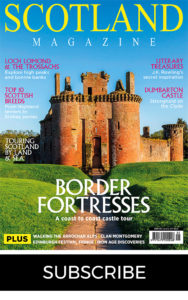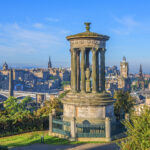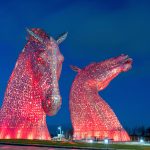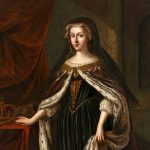MORE FROM SCOTLAND MAGAZINE
Queen Elizabeth II: Scotland says goodbye
We follow Queen Elizabeth II’s final journey through Scotland, from her beloved Balmoral to Edinburgh’s St Giles’ Cathedral
They came in their tens of thousands, residents of and visitors to Edinburgh, who lined the Royal Mile and crammed into the streets around it to pay their respects to Her Majesty Queen Elizabeth II, who had died at Balmoral Castle just days before.
Each year, from mid-July to October, Her Majesty made Balmoral, her great, great grandmother’s “dear paradise in the Highlands”, her home – staying at first at Craigowan Lodge on the estate, before moving into the main castle when it closed to the public in early August.
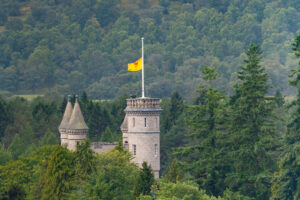
And so, it may just have been a coincidence that it was at Balmoral that the Queen spent her final few weeks, but she no doubt took great comfort from the familiar surroundings of her 50,000-acre Aberdeenshire holiday estate in her final days and hours, as she was said to feel so at home here that she effectively left her crown at the gates.
On 6 September, in a break from protocol, the Queen both accepted former Prime Minister Boris Johnson’s official resignation, and invited the new Prime Minister, Liz Truss, to form a government at Balmoral (a ceremonial duty usually carried out at Buckingham Palace).
This gave some indication of Her Majesty’s declining health, and so when an unprecedented announcement from the Palace on the afternoon of 8 September said that doctors were concerned about the Queen and “have recommended she remain under medical supervision,” it became clear that the end was near.
Over the next few hours, the eyes of the world turned to Balmoral, and viewers waited with bated breath for the news none of us wanted to hear. The mood of the nation – and across the world – turned sombre as reports came through that members of the Royal Family were flying to Scotland to be by the Queen’s side. After landing in Aberdeen, Prince William drove Prince Andrew, Prince Edward, and Sophie, Countess of Wessex, to Balmoral.
We now know that the Queen’s eldest son, (then) Prince Charles, and her only daughter, Princess Anne, were already at her bedside. During the afternoon, news readers began dressing in black, amid growing concern that an announcement would soon be made, and then at 6.30pm it came, with an official announcement from the Palace that said: “The Queen died peacefully at Balmoral this afternoon. The King and The Queen Consort will remain at Balmoral this evening and will return to London tomorrow.” Prince Harry was still on his way to Balmoral when the announcement was made.
Shortly afterwards, mourners began leaving flowers at the gates of Balmoral and by the time the Queen’s cortège made its way through the nearby village of Ballater on the morning of 11 September, a knitted topper of the Queen had appeared on the Royal Deeside village’s postbox.
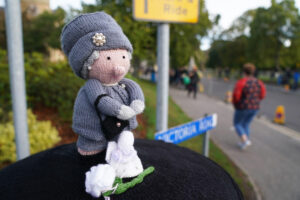
The Queen was known to many in Ballater; indeed, locals considered her as more than just royalty but as a neighbour, and have memories of having seen her in the hills around the area or glimpsing the new King and other members of the Royal Family in the local shops and cafés.
As the Queen left Balmoral for the last time, her coffin was draped in the Royal Standard of Scotland, and was accompanied by several police motorcycles. It passed by Crathie Kirk, the humble granite church where the Queen attended Sunday services while staying at Balmoral, before travelling through the village of Ballater, where many of the Queen’s neighbours, as well as visitors from across the world, stood in revered silence as the cortège passed through.
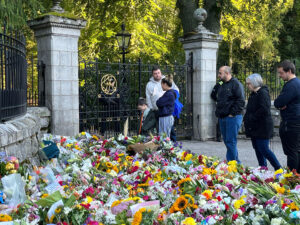
Lord Lieutenant Sandy Manson told the Press and Journal, “She was so engaged in this community, she so loved this community, and we loved her.”
From Ballater, the cortège passed through Aberdeen, Perth, Dundee, and across the Queensferry Crossing, which the Queen had opened in 2017, some 53 years after she had opened the adjacent Forth Road Bridge.
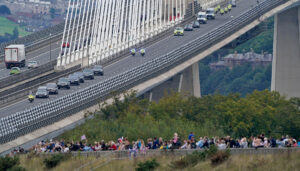
On arrival in Edinburgh, the coffin was placed in the Throne Room of the Palace of Holyroodhouse, the monarch’s official residence in Scotland. In June 2022, Her Majesty The Queen had made her first appearance since the Jubilee Celebrations at the Palace of Holyroodhouse during Royal Week, in which she took part in the pageantry of the Ceremony of the Keys.
On Monday 12 September, King Charles took part in the ceremony for the first time on the palace forecourt. During the ceremony, the monarch is handed the keys of the city of Edinburgh by the Lord Provost in a move that welcomes them to their “ancient and hereditary kingdom of Scotland”.
The monarch then hands the keys back, entrusting them to the city’s elected officials. Shortly after the ceremony, the Queen’s coffin was taken by procession from the Palace of Holyroodhouse up the medieval cobbles of the Royal Mile to St Giles’ Cathedral – a journey of just 0.7 miles.
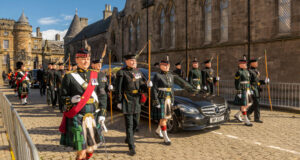
During the procession, the coffin was once again draped in the Royal Standard, flanked by the Bearer Party from the Royal Regiment of Scotland, and escorted by members of the Royal Company of Archers – the monarch’s body guard in Scotland.
The coffin was followed by the Queen’s four children, Charles, Anne, Andrew, and Edward, with guns fired every minute from Edinburgh Castle. On arrival at St Giles,’ the High Kirk of Edinburgh and a church where the Queen is known to have worshipped, as well as participated in Order of the Thistle ceremonies, a final round of shots was fired, and the Queen’s coffin was then carried inside.
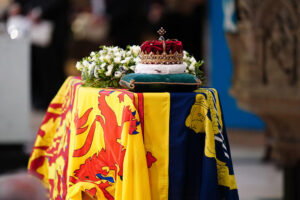
Once inside, the 16th-century Crown of Scotland – the centrepiece of the Honours of Scotland (Scotland’s Crown Jewels), made for the Queen’s ancestor King James V, was placed on top of the coffin. The Service of Thanksgiving was sung by the Choir of St Giles’ Cathedral and conducted by Mr Michael Harris, the Master of Music, with the organ played by Jordan English, Assistant Organist of St Giles’ Cathedral. The service was a historic moment, but by no means the only historic event to take place at the cathedral, as St Giles’ minister, the Reverend Calum MacLeod, pointed out.
“Here at St Giles,” the Reverend said, “John Knox confronted Mary, Queen of Scots, King James VI argued about liturgy, Oliver Cromwell preached, and our late Queen received the Honours of Scotland, on her accession to the throne 70 years ago.”
Just like that happier occasion in 1953, when the Queen and Prince Philip paraded through the streets of Edinburgh to the cathedral, on this day, the Royal Mile was lined with well-wishers, though this time the mood was more solemn.
Shortly after the service, the King and the Queen Consort were escorted into the chamber of the Scottish Parliament building, which the Queen opened 23 years ago, by the Royal Company of Archers. The MSPs stood for a two-minute silence before each party leader spoke in support of a motion of condolence, beginning with First Minister Nicola Sturgeon, who said: “Our nation is in mourning for a Queen whose loss we have not yet begun to come to terms with.
“We are deeply honoured by the presence today of His Majesty King Charles III and the Queen Consort. Your Majesty, we stand ready to support you as you continue your own life of service and as you build on the extraordinary legacy of your beloved mother, our Queen. Queen Elizabeth, Queen of Scots, we are grateful for her life. May she now rest in peace.”
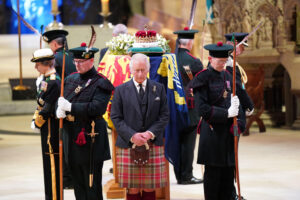
King Charles addressed the MSPs with a speech about his mother, saying: “Through all the years of her reign, the Queen, like so many generations of our family before her, found in the hills of this land and in the hearts of its people a haven and a home.”
The King also paraphrased Robert Burns saying: “My dear mother was the friend of man, the friend of truth, the friend of age and guide of youth. Few hearts like hers, with virtue warmed, few heads with knowledge so informed.”
It is now strongly rumoured that King Charles plans to open Balmoral Castle up further to members of the public as a memorial to his mother and her love of Scotland.
The Queen lay in state in St Giles’ Cathedral with the Royal Company of Archers keeping vigil from the evening of Monday 12 September until the afternoon of Tuesday 13 September, with members of the public able to walk past the coffin to pay their respects.
On 13 September, Princess Anne escorted her mother’s coffin as it made its final journey from Scotland, travelling by hearse to Edinburgh Airport, and from there on to London. As the coffin was brought out of St Giles’ Cathedral, gathered onlookers could hear a lone piper playing Flowers of the Forest from within the cathedral precinct.
A fitting farewell to a Queen who had indeed taken Scotland into her heart.
This is an extract. Read the full feature in the November/December 2022 issue of Scotland, available to buy from Friday 14 October.
Read more:

SCOTLAND MAGAZINE
Published six times a year, every issue of Scotland showcases its stunning landscapes and natural beauty, and delves deep into Scottish history. From mysterious clans and famous Scots (both past and present), to the hidden histories of the country’s greatest castles and houses, Scotland‘s pages brim with the soul and secrets of the country.
Scotland magazine captures the spirit of this wild and wonderful nation, explores its history and heritage and recommends great places to visit, so you feel at home here, wherever you are in the world.
